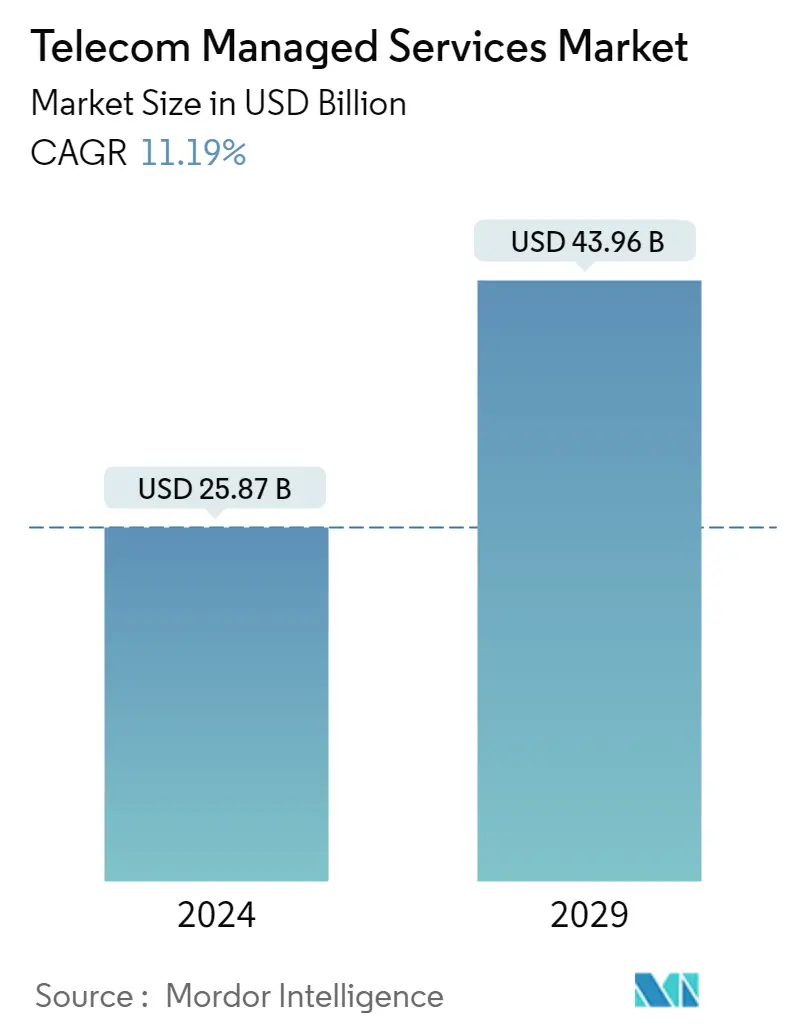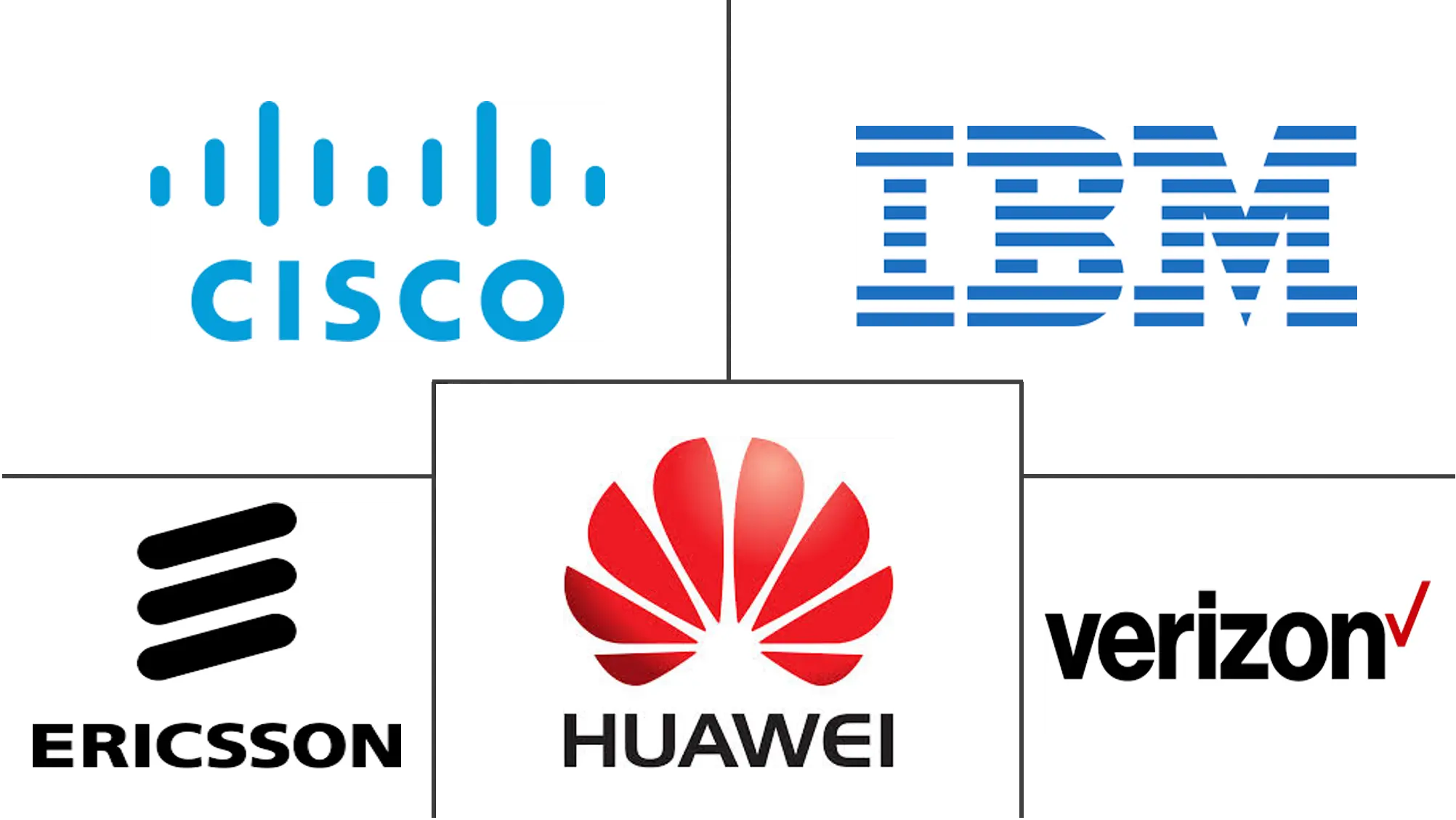Market Size of Telecom Managed Services Industry

| Study Period | 2021 - 2029 |
| Market Size (2024) | USD 25.87 Billion |
| Market Size (2029) | USD 43.96 Billion |
| CAGR (2024 - 2029) | 11.19 % |
| Fastest Growing Market | Asia Pacific |
| Largest Market | North America |
| Market Concentration | High |
Major Players
*Disclaimer: Major Players sorted in no particular order |
Telecom Managed Services Market Analysis
The Telecom Managed Services Market size is estimated at USD 25.87 billion in 2024, and is expected to reach USD 43.96 billion by 2029, growing at a CAGR of 11.19% during the forecast period (2024-2029).
The telecom sector is a significant market for managed services due to the high rate of various technological adoptions, increased frequency of confirmation of the BYOD policy (to make business operations much more comfortable and controllable), and the increased need for high-end security due to the rapidly increasing data among the organizations.
- The telecom industry observed extensive growth during the past few years. Telecommunication companies are constantly pressured to deliver innovative services at lower costs to retain their customers in the competitive market. The factors, such as the constant requirement for network optimizations and the significant level of network performance, advancements in technologies, such as SDN, 5G, and NFV, growing smartphone usage and BYOD trends, and the growing number of cyber-attacks, will further encourage the growth of the telecom managed services market during the forecast period.
- Since telecom businesses are increasing rapidly, enterprises frequently rely on MSPs (Managed Service Providers). An MSP helps enterprises achieve excellent business outcomes by providing a significant level of service. The companies mostly face several challenges in terms of revenue, business transformation, cost implementation, and heightened competition in the marketplace in the telecom sector, due to which they depend on MNOs and CSPs. Moreover, various SD-WAN-managed service providers distinguish themselves with a broad range of security offerings. For instance, Cato Networks gives a cloud-native platform that includes NGFW, Advanced Threat Prevention, CloudSecure Web Gateway, Mobile Access Protection, and Managed Threat Detection and Response service.
- Telecom companies are also acquiring managed service providers to gain a more significant market share. For instance, recently this year, Networking systems, services, and software provider Ciena Corporation revealed that it had signed a binding agreement to buy privately held Tibit Communications, Inc. with headquarters in Petaluma, California, as well as privately held Benu Networks, Inc. with offices in Burlington, Massachusetts. Tibit and Benu mainly focus on simplifying broadband access networks with enhanced subscriber management and next-generation PON technologies.
- Determinants, such as security concerns related to the confidentiality of data of businesses that are outsourcing the business and assuring the optimum business functionality of the clients, are expected to restrict the market growth during the forecast period.
- However, due to the COVID-19 outbreak, operational services, like telecom managed services and support services, were affected globally. Moreover, due to this pandemic, a broad range of firms has significantly undergone a long-term work-from-home culture. Hence, most organizations are turning to service providers for their ability to minimize various security-related risks with the value-added service they offer, which drives the market exponentially.
Telecom Managed Services Industry Segmentation
Managed services refer to a concept where a third-party service provider manages an organization's in-house, day-to-day management functions. Telecom-managed services allow organizations to minimize their costs in business operations, focusing more on fundamental techniques and essential business exercises, cutting down dangers primarily related to business operations, and upgrading operational precision and effectiveness.
The Telecom Managed Services Market is Segmented by Organization Size (Large Enterprises, Small and Medium Enterprises), Service Type (Managed Data Center Services, Managed Security Services, Managed Network Services, Managed Data and Information Services), and Geography. The market sizes and forecasts are provided in terms of value (USD million) for all the above segments.
| By Organization Size | |
| Large Enterprises | |
| Small and Medium Enterprises |
| By Service Type | |
| Managed Data Center Services | |
| Managed Security Services | |
| Managed Network Services | |
| Managed Data and Information Services | |
| Other Service Types (Managed Communication Services and Managed Mobility Services) |
| Geography | |
| North America | |
| Europe | |
| Asia Pacific | |
| Latin America | |
| Middle-East & Africa |
Telecom Managed Services Market Size Summary
The telecom managed services market is experiencing significant growth, driven by the rapid adoption of advanced technologies and the increasing need for high-end security solutions. As telecom companies strive to deliver innovative services while managing costs, they are increasingly relying on managed service providers (MSPs) to optimize network performance and enhance operational efficiency. The market is characterized by the integration of technologies such as SDN, 5G, and NFV, which are pivotal in addressing the challenges posed by growing smartphone usage, BYOD trends, and the rising incidence of cyber-attacks. The strategic acquisition of MSPs by telecom companies further underscores the competitive landscape, as firms seek to expand their market share and enhance their service offerings.
Cloud computing has emerged as a transformative force in the telecom managed services market, offering opportunities for cost reduction and improved business functionality. The adoption of cloud technologies, particularly by small and medium-sized enterprises, has facilitated the efficient allocation and management of resources, thereby driving market growth. The market is witnessing a surge in mergers, acquisitions, and strategic partnerships, as key players aim to enhance their presence and meet the evolving needs of customers. North America is poised to dominate the market, fueled by technological advancements, the presence of major telecom firms, and the increasing adoption of BYOD policies. The market's consolidation is evident, with significant players investing in organic and inorganic growth strategies to maintain their competitive edge.
Telecom Managed Services Market Size - Table of Contents
-
1. MARKET INSIGHTS
-
1.1 Market Overview
-
1.2 Industry Value Chain Analysis
-
1.3 Industry Attractiveness - Porter's Five Forces Analysis
-
1.3.1 Bargaining Power of Suppliers
-
1.3.2 Bargaining Power of Buyers
-
1.3.3 Threat of New Entrants
-
1.3.4 Threat of Substitutes
-
1.3.5 Intensity of Competitive Rivalry
-
-
1.4 Assessment of the Impact of COVID-19 on the Telecom Managed Services Market
-
-
2. MARKET SEGMENTATION
-
2.1 By Organization Size
-
2.1.1 Large Enterprises
-
2.1.2 Small and Medium Enterprises
-
-
2.2 By Service Type
-
2.2.1 Managed Data Center Services
-
2.2.2 Managed Security Services
-
2.2.3 Managed Network Services
-
2.2.4 Managed Data and Information Services
-
2.2.5 Other Service Types (Managed Communication Services and Managed Mobility Services)
-
-
2.3 Geography
-
2.3.1 North America
-
2.3.2 Europe
-
2.3.3 Asia Pacific
-
2.3.4 Latin America
-
2.3.5 Middle-East & Africa
-
-
Telecom Managed Services Market Size FAQs
How big is the Telecom Managed Services Market?
The Telecom Managed Services Market size is expected to reach USD 25.87 billion in 2024 and grow at a CAGR of 11.19% to reach USD 43.96 billion by 2029.
What is the current Telecom Managed Services Market size?
In 2024, the Telecom Managed Services Market size is expected to reach USD 25.87 billion.

